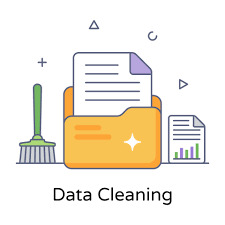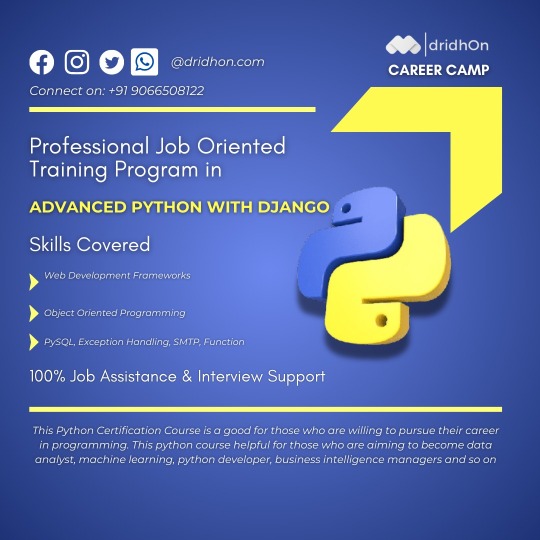#Machine_Learning
Explore tagged Tumblr posts
Photo

The AI revolution has unleashed a wave of creative possibilities for designers like Vojtek Morsztyn. By blending AI and traditional design methods, he's exploring uncharted territories in design. Let's join this journey of discoveries!
#aianddesign#designrevolution#vojtekmorsztyn#creativepossibilities#designfuture#rendering3d#renderart#design#architecture#3dmodel#designer#designinspiration#designeveryday#model3d#design3d#ai#artificialintelligence#picoftheday#future#machine_learning#futureofwork#newarchitecture#futureplanning
7 notes
·
View notes
Text
Data Cleaning in Data Science

Data cleaning is an integral part of data preprocessing viz., removing or correcting inaccurate information within a data set. This could mean missing data, spelling mistakes, and duplicates to name a few issues. Inaccurate information can lead to issues during analysis phase if not properly addressed at the earlier stages.
Data Cleaning vs Data Wrangling : Data cleaning focuses on fixing inaccuracies within your data set. Data wrangling, on the other hand, is concerned with converting the data’s format into one that can be accepted and processed by a machine learning model.
Data Cleaning steps to follow :
Remove irrelevant data
Resolve any duplicates issues
Correct structural errors if any
Deal with missing fields in the dataset
Zone in on any data outliers and remove them
Validate your data
At EduJournal, we understand the importance of gaining practical skills and industry-relevant knowledge to succeed in the field of data analytics / data science. Our certified program in data science and data analytics is designed to equip freshers / experienced with the necessary expertise and hands-on experience experience so they are well equiped for the job.
URL : http://www.edujournal.com
#data_science#training#upskilling#irrevelant_data#duplicate_issue#datasets#validation#outliers#data_cleaning#trends#insights#machine_learning
2 notes
·
View notes
Text
The Role of AI and Machine Learning in Engineering Careers

Engineering has always been about solving real-world problems through creativity and logic. But today, with the rise of Artificial Intelligence (AI) and Machine Learning (ML), engineering is evolving faster than ever before. These technologies are not just fancy buzzwords — they are changing how engineers work, design, and innovate across all fields.
Whether you’re aiming to become a computer engineer, mechanical expert, civil builder, or IT professional, understanding AI and ML can open exciting career doors. Let’s explore how these tools are shaping the future of engineering and why students in Dehradun and across India are embracing them.
What Are AI and Machine Learning?
Before we go further, let’s understand what these terms mean:
Artificial Intelligence (AI) is when machines are programmed to “think” like humans — making decisions, recognizing patterns, and solving problems.
Machine Learning (ML) is a part of AI where machines “learn” from data. The more data they get, the smarter they become.
Think of it like this: AI is the brain, and ML is how the brain learns.
From facial recognition in your phone to personalized shopping ads, AI and ML are already around us. But now, they’re also transforming engineering.
Why AI & ML Are Crucial in Engineering Today
Here’s why these technologies are becoming essential in engineering careers:
1. Automation of Repetitive Tasks
AI can handle routine tasks that engineers used to do manually, like:
Drafting blueprints
Analyzing test data
Checking for design errors
This saves time and allows engineers to focus on more complex problems.
2. Better Data Analysis
Modern engineering involves lots of data. AI-powered systems can:
Process huge amounts of information quickly
Spot patterns humans might miss
Help engineers make smarter decisions
This is especially helpful in fields like civil engineering, mechanical design, and software development.
3. Smarter Design and Prototyping
AI tools help engineers:
Simulate products before building them
Test different materials virtually
Optimize designs for strength, weight, or cost
This leads to faster, cheaper, and more efficient product development.
How Different Engineering Fields Use AI & ML
Let’s break it down by popular engineering streams:
Computer Science Engineering
Students in a Btech CS engineering college in Dehradun or other cities often dive deep into AI and ML. Key areas include:
Creating chatbots and virtual assistants
Designing intelligent apps
Improving cybersecurity systems
Building algorithms for big data analysis
It’s one of the most in-demand fields today, with job opportunities in tech giants and…
To read more, visit: https://freshvoicehub.com/the-role-of-ai-and-machine-learning-in-engineering-careers/
0 notes
Text

Predictive Maintenance with AI: Cut Downtime & Boost Efficiency
👉 Whatsapp: https://t.ly/ebhuR
👉 Linkedin: https://rb.gy/krtag
👉 Telegram: https://rb.gy/0cc12
👉 Medium: https://medium.com/@akashkoringa
#predictive_maintenance#ai_maintenance#downtime_reduction#machine_learning#maintenance_ai#equipment_efficiency#industrial_ai#smart_maintenance#predictive_analytics#maintenance_technology#condition_monitoring#ai_for_industry#preventive_maintenance#iot_maintenance#ai_driven_maintenance#factory_automation#industrial_efficiency#equipment_monitoring#predictive_algorithms#maintenance_optimization
0 notes
Text
0 notes
Text

If you’re looking for a clear starting point to help you build a career or learn how to design applications and systems on Python, then this Python Training and Certification is for you:
Join dridhOn's Python Course with placement and Certification: http://bit.ly/3xWQmED
To talk to our Career Adviser, Call Us or WhatsApp Now +91 9066508122
#training#programming#python#pythonprogramming#programmingmemes#trainingcamp#pythons#pythoncode#pythontraining#programmings#linux#php#developer#coder#html#javascript#trainning#programmers#webdeveloper#softwaredeveloper#programmer#codinglife#softwareengineer#computerscience#reactjs#angular#programmerlife#nodejs#artificial_intelligence#machine_learning
0 notes
Text
(Export to Kazakhstan)Bean to cup +snacks and cold drinks vending machine
#vendingmachine#coffee#snacks#groundcoffee#freshly#freshlyroastedcoffee#freshlyground#afenvendingmachine#drink#snack#vending#machine_learning
0 notes
Link
Almost all parameters are unknown The Chinese company Loongson produces not only some of the most modern Chinese processors, but also GPUs. And its new development is designed to compete with Nvidia accelerators for AI, although they are far from the most productive and modern. [caption id="attachment_85288" align="aligncenter" width="600"] Loongson introduced LG200 AI accelerator[/caption] The accelerator (or its GPU) is called LG200. The characteristics of this solution, unfortunately, are unknown. The block diagram shows that the GPU consists of 16 small ALUs, four large ALUs, and one huge ALU or special purpose unit. Loongson introduced LG200 AI accelerator But the performance is known, albeit for the whole node: from 256 GFLOPS to 1 TFLOPS. Here, unfortunately, the details are again unknown, so it is unclear for which mode the performance is indicated, but even if it is FP64, the figure is quite modest, since modern monsters Nvidia and AMD offer 50-60 TFLOPS or more. At the same time, Loongson’s solution is a GPGPU, that is, it supports general-purpose computing. Unfortunately, there are no details here yet. Separately, we can recall that Loongson promised next year to release a video card that can compete with the Radeon RX 550 , whose performance (FP32) is just over 1.1 TFLOPS. It is possible that the LG200 will be a direct relative of this adapter.
#accelerators_in_computing#advanced_computing#AI_Accelerator#AI_Hardware#AI_Processing#Artificial_Intelligence.#Chinese_Technology#computing_hardware#deep_learning#Hardware_acceleration#LG200#Loongson#Loongson_AI_products.#Loongson_LG200_specifications#machine_learning#neural_networks#processor_architecture#semiconductor_industry#semiconductor_technology#Technology_innovation
0 notes
Text
Postdoctoral Research Scientist Earlham Institute Applications are invited for a Postdoctoral Research Scientist to join the Research Faculty Department at the Earlham Institute, based in Norwich, UK. See the full job description on jobRxiv: https://jobrxiv.org/job/earlham-institute-27778-postdoctoral-research-scientist-7/?feed_id=96202 #bioinformatics #computational_biology #computational_genomics #epigenomics #machine_learning #perl #Python #transcriptomic_data #ScienceJobs #hiring #research
0 notes
Text
🚀𝐇𝐨𝐰 𝐈𝐨𝐓 𝐒𝐞𝐧𝐬𝐨𝐫𝐬 𝐀𝐫𝐞 𝐑𝐞𝐯𝐨𝐥𝐮𝐭𝐢𝐨𝐧𝐢𝐳𝐢𝐧𝐠 𝐈𝐧𝐝𝐮𝐬𝐭𝐫𝐢𝐞𝐬 𝐢𝐧 𝟐𝟎𝟐𝟓 | IndustryARC™
The global IoT sensors market size was estimated at USD 13.36 billion in 2023 and is expected to grow at a CAGR of 36.8% from 2024 to 2030.
👉𝑫𝒐𝒘𝒏𝒍𝒐𝒂𝒅 𝑺𝒂𝒎𝒑𝒍𝒆 𝑹𝒆𝒑𝒐𝒓𝒕
The #IoT #Sensors Market refers to the industry focused on sensors that are used in Internet of Things (#IoT) applications. These sensors collect and transmit data, enabling smart devices, industrial automation, and real-time monitoring across various sectors.
🔹𝐈𝐧𝐜𝐫𝐞𝐚𝐬𝐞𝐝 𝐔𝐬𝐞 𝐨𝐟 𝐀𝐈 𝐚𝐧𝐝 𝐌𝐚𝐜𝐡𝐢𝐧𝐞 𝐋𝐞𝐚𝐫𝐧𝐢𝐧𝐠:
Edge Computing combined with #AI and #machine_learning will help process sensor #data faster and more efficiently, reducing latency and bandwidth usage. Sensors will become smarter, capable of performing complex analytics at the edge, enabling real-time decision-making without the need for a central cloud server.
Request PDF Sample Copy of Report: (Including Full TOC, List of Tables & Figures, Chart)
🔹𝐌𝐢𝐧𝐢𝐚𝐭𝐮𝐫𝐢𝐳𝐚𝐭𝐢𝐨𝐧 𝐨𝐟 𝐒𝐞𝐧𝐬𝐨𝐫𝐬:
As IoT applications require more compact, energy-efficient devices, we can expect sensors to become increasingly smaller while maintaining or enhancing their performance. Miniaturized sensors will enable integration into a wide variety of devices, especially in wearables, healthcare, and smart consumer products.
𝐒𝐦𝐚𝐫𝐭 𝐒𝐞𝐧𝐬𝐨𝐫𝐬 𝐰𝐢𝐭𝐡 𝐌𝐮𝐥𝐭𝐢-𝐟𝐮𝐧𝐜𝐭𝐢𝐨𝐧𝐚𝐥𝐢𝐭𝐲:
The trend toward multi-sensor devices that combine various sensing capabilities in one chip (e.g., temperature, humidity, and pressure sensing in a single sensor) will continue to grow.
Get this Report on discount of $1000 on purchase of Credit Card
𝐓𝐲𝐩𝐞𝐬 𝐨𝐟 𝐈𝐨𝐓 𝐒𝐞𝐧𝐬𝐨𝐫𝐬:
🔹Temperature Sensors (e.g., HVAC, smart thermostats)
🔹Pressure Sensors (e.g., industrial automation, smart grids)
🔹Proximity Sensors (e.g., automotive, retail)
🔹Motion & Occupancy Sensors (e.g., security systems, smart homes)
🔹Gas Sensors (e.g., air quality monitoring, smart agriculture)
🔹Image & Optical Sensors (e.g., smart cameras, biometric systems)
🔹Humidity Sensors (e.g., weather forecasting, industrial control)
➡️ 𝐤𝐞𝐲 𝐏𝐥𝐚𝐲𝐞𝐫𝐬 : NXP Semiconductors | Bosch Global Software Technologies | Honeywell Industrial Automation | Amkor Technology, Inc. | KYOCERA AVX Components Corporation | Parker Electromechanical and Drive Technology | C&K | BOE Technology Group Co., Ltd. | Spark Minda | Salcomp Plc | TDK Americas | ALPS ALPINE Europe | Panoramic Power | TESEO S.p.A — Eiffage Energy Systems Italy | Advantech Malaysia |
#IoTSensors#SmartSensors#IIoT#IndustrialIoT#EdgeComputing#AIoT#IoTDevices#SensorTechnology#IoTAnalytics#5GIoT#WirelessSensors#ConnectedDevices#Automation#Industry40#DigitalTransformation#EmbeddedSensors#SmartManufacturing#DataDriven#CloudIoT#IoTInnovation
0 notes
Text
An Intuitive Explanation of Sparse Autoencoders for LLM Interpretability
https://adamkarvonen.github.io/machine_learning/2024/06/11/sae-intuitions.html
0 notes
Photo

Vojtek Morsztyn's seamless collaboration between AI and traditional design is truly inspiring. The potential for innovation and breakthroughs seems limitless. Exciting times ahead for the design industry!
#aidesign#designinnovation#vojtekmorsztyn#designbreakthroughs#futureofdesign#rendering3d#renderart#design#architecture#3dmodel#designer#designinspiration#designeveryday#model3d#design3d#ai#artificialintelligence#picoftheday#future#machine_learning#futureofwork#newarchitecture#futureplanning
1 note
·
View note
Text
Benefits of Big Data in insurance sector

The insurance industry, as we know is founded on estimating futurestic events and accessing the risk and value for these events whick by the way require massive datasets with data from sensors, government, customer interactions and social media etc., Today big data technology has been comprehensively used to determine risks, claims, etc., with high levels of predictive accuracy. Big Data are useful in the insurance sector for the following reasons:
Risk Assessment
Understanding of customer behavior,habits, needs to anticipate future behavior and offer relevant products.
Improve Fraud Detection and criminal activity through predictive modelling
Provide targetted products and services.
Check out our master program in Data Science, Data Analytics and ASP.NET- Complete Beginner to Advanced course and boost your confidence and knowledge.
URL: www.edujournal.com
#risk#customer#product#fraud_detection#services#predictive modelling#machine_learning#insight#trends#training
0 notes
Note
Adobe ToS update 4.2: Licenses your content. solely for the purposes of operating or improving the Services and Software, you grant us a non-exclusive, worldwide, royalty-free sublicensable, license, to use, reproduce, publicly display, distribute, modify, create derivative works based on, publicly perform, and translate the Content. For example, we may sublicense our right to the Contents to our service providers or to other users to allow the Services and Software to operate as intended, such as enabling you to share photos with others. Separately, section 4.6 (Feedback) below covers Feedback that you provide for us.
2.2 Our Access to Your Content. We may access, view, or listen to your Content (defined in section 4.1 (Content) below) through both automated and manual methods, but only in limited ways, and only as permitted by law. For example, in order to provide the Services and Software, we may need to access, view, or listen to your Content to (A) respond to Feedback or support requests; (B) detect, prevent, or otherwise address fraud, security, legal, or technical issues; and (C) enforce the Terms, as further set forth in Section 4.1 below. Our automated systems may analyze your Content and Creative Cloud Customer Fonts (defined in section 3.10 (Creative Cloud Customer Fonts) below) using techniques such as machine learning in order to improve our Services and Software and the user experience. Information on how Adobe uses machine learning can be found here: http://www.adobe.com/go/machine_learning
???
1 note
·
View note